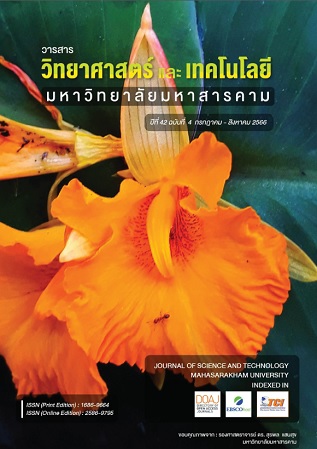Blending Agricultural Residue as a Source for Biofuel Production
Main Article Content
Abstract
Agricultural residue becomes a renewable energy source with potential and importance. When using agricultural residue for energy production, it is essential to study the properties and characterizations. Each biomass has different properties, characteristics, and availability during various seasons. This study aimed to examine the properties and characteristics of five biomass materials including rice stubble (RB), rice straw (RW), sugar cane leaves (SL), cassava leaves (CL), and cassava rhizome (CR). Material blending scheme was also investigated depeding on their seasonal availability to produce renewable energy fuels. RB, RW, and SL were categorized as the main materials in all season and the rest are supplement materials. The results showed that CL had the highest heat value (19.29 MJ/kg). SL contained the highest volatile matter (75.69 wt%), and CR had the highest fixed carbon (15.27 wt%), and lowest ash content (3.77 wt%). The two-type blending of main materials results showed that SL:RW at a ratio of 80:20 contained the highest heat value (16.08 MJ/kg). Three-type blending showed that SL:RW:RB at a ratio of 60:20:20 had the highest heat value (15.68 MJ/kg). The improvement of energy properties with supplement materials (CL and CR) showed that RW:CL (50:50) ratio had the highest heat value of 16.25 MJ/kg. The study shows that heat value increases with an increase of in the ratio of supplement materials (CL and CR), and the amount of ash tends to decrease.
Article Details
References
กรมพัฒนาพลังงานทดแทนและอนุรักษ์พลังงาน. (2564). ฐานข้อมูลศักยภาพชีวมวลในประเทศไทย ประจำปีเพาะปลูก พ.ศ.2556. สืบค้นจาก URL:http://webkc.dede.go.th/testmax/node/2450. 1 กุมภาพันธ์.
กระทรวงอุตสาหกรรม. (2565). มาตรฐานผลิตภัณฑ์อุตสาหกรรมเชื้อเพลิงชีวมวลแข็งอัดเม็ด (มอก. 2772-2560). สืบค้นจาก URL: https://www.tisi.go.th/website/standardlist/tis_5. 15 มกราคม.
ปิ่นมนัส วิโสรัมย์. (2563). การปรับปรุงประสิทธิภาพทางพลังงานของเชื้อเพลิงจากหญ้าหลายฤดู. วิทยานิพนธ์วิทยาศาสตรมหาบัณฑิต. สาขาวิชาเทคโนโลยีสิ่ง
แวดล้อม. มหาวิทยาลัยมหาสารคาม.
วิจิตรา สิงห์หิรัญนุสรณ์, ปิ่นมนัส วิโสรัมย์ และเพชรรัตน์ บุญร่วม. (2560). การกระจายเชิงพื้นที่ของเชื้อเพลิงชีวภาพรุ่นที่สองและศักยภาพในการใช้ผลิตพลังงาน
ทดแทน: กรณีศึกษาชีวมวลจากวัสดุเหลือทิ้งทางการเกษตรภายในจังหวัดมหาสารคาม. การประชุมวิชาการมหาวิทยาลัยมหาสารคามวิจัย ครั้งที่ 14, มหาวิทยาลัย
มหาสารคาม: 266-277
Anukam, A. I., Mamphweli, S. N., Mabizela, P. S., and Meyer, E. L. (2016). Blending Influence on the Conversion Efficiency of the Cogasification Process of Corn Stover and Coal. Journal of Chemistry, 2016, 1-8.
Daioglou, V., Stehfest, E., Wicke, B., Faaij, A., and van Vuuren, D. P. (2016). Projections of the availability and cost of residues from agriculture and forestry. GCB Bioenergy, 8(2), 456-470.
Domingos, I., Ayata, U., Ferreira, J., Cruz-Lopes, L., Sen, A., Sahin, S. and Esteves, B. (2020). Calorific Power Improvement of Wood by Heat Treatment and Its Relation to Chemical Composition. Energies 13(20).
Konrad Kaczynski, K. K., and Piotr, P. (2019). Characteristics of agro and wood biomass combustion in the stream of inert material. E3S Web of Conferences, 137, 01031. local firing systems in Brazil. Biomass and Bioenergy, 123, 70-77.
Maksimuk, Y., Antonava, Z., Krouk, V., Korsakova A. and Kursevich, V. (2021). Prediction of higher heating value (HHV) based on the structural composition for biomass. Fuel 299.
Mendoza Martinez, C. L., Sermyagina, E., de Cassia Oliveira Carneiro, A., Vakkilainen, E., and Cardoso, M. (2019). Production and characterization of coffee-pine wood residue briquettes as an alternative fuel for local firing systems in Brazil. Biomass and
Bioenergy, 123, 70-77
Ray, A. E., Li, C., Thompson, V. S., Daubaras, D. L., Nagle, N., and Hartley, D. S. (2017). Biomass Blending and Densification: Impacts on Feedstock Supply and Biochemical Conversion Performance. The INL is a U.S. Department of Energy National Laboratory
Sasongko, D., Wulandari, W., Rubani, I. S., and Rusydiansyah, R. (2017). Effects of biomass type, blend composition, and co-pyrolysis temperature on hybrid coal quality. 1805: 040009.
Tumuluru, J. S., Wright, C. T., Hess, J. R., and Kenney, K. L. (2011). A review of biomass densification systems to develop uniform feedstock commodities for bioenergy application. Biofuels, Bioproducts and Biorefining, 5(6), 683-707.


